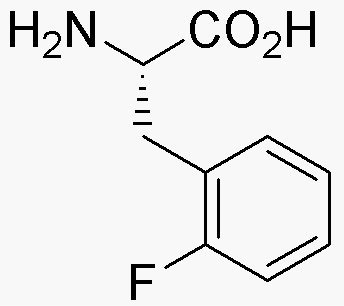2-Fluoro-L-phenylalanine is widely utilized in research focused on:
- Drug Development: This compound serves as a valuable building block in the synthesis of novel pharmaceuticals, particularly in creating targeted therapies for various diseases.
- Biochemical Research: It is used in studies to investigate protein interactions and enzyme activities, helping researchers understand metabolic pathways and disease mechanisms.
- Neuroscience: The compound is applied in neuropharmacology to explore its effects on neurotransmitter systems, aiding in the development of treatments for neurological disorders.
- Radiolabeling: 2-Fluoro-L-phenylalanine can be utilized in radiolabeling techniques for imaging studies, enhancing the visualization of biological processes in vivo.
- Protein Engineering: It is employed in the design of modified proteins, allowing scientists to create more effective enzymes or antibodies with improved stability and activity.
General Information
Properties
Safety and Regulations
Applications
2-Fluoro-L-phenylalanine is widely utilized in research focused on:
- Drug Development: This compound serves as a valuable building block in the synthesis of novel pharmaceuticals, particularly in creating targeted therapies for various diseases.
- Biochemical Research: It is used in studies to investigate protein interactions and enzyme activities, helping researchers understand metabolic pathways and disease mechanisms.
- Neuroscience: The compound is applied in neuropharmacology to explore its effects on neurotransmitter systems, aiding in the development of treatments for neurological disorders.
- Radiolabeling: 2-Fluoro-L-phenylalanine can be utilized in radiolabeling techniques for imaging studies, enhancing the visualization of biological processes in vivo.
- Protein Engineering: It is employed in the design of modified proteins, allowing scientists to create more effective enzymes or antibodies with improved stability and activity.
Documents
Safety Data Sheets (SDS)
The SDS provides comprehensive safety information on handling, storage, and disposal of the product.
Product Specification (PS)
The PS provides a comprehensive breakdown of the product’s properties, including chemical composition, physical state, purity, and storage requirements. It also details acceptable quality ranges and the product's intended applications.
Certificates of Analysis (COA)
Search for Certificates of Analysis (COA) by entering the products Lot Number. Lot and Batch Numbers can be found on a product’s label following the words ‘Lot’ or ‘Batch’.
*Catalog Number
*Lot Number
Certificates Of Origin (COO)
This COO confirms the country where the product was manufactured, and also details the materials and components used in it and whether it is derived from natural, synthetic, or other specific sources. This certificate may be required for customs, trade, and regulatory compliance.
*Catalog Number
*Lot Number
Safety Data Sheets (SDS)
The SDS provides comprehensive safety information on handling, storage, and disposal of the product.
DownloadProduct Specification (PS)
The PS provides a comprehensive breakdown of the product’s properties, including chemical composition, physical state, purity, and storage requirements. It also details acceptable quality ranges and the product's intended applications.
DownloadCertificates of Analysis (COA)
Search for Certificates of Analysis (COA) by entering the products Lot Number. Lot and Batch Numbers can be found on a product’s label following the words ‘Lot’ or ‘Batch’.
*Catalog Number
*Lot Number
Certificates Of Origin (COO)
This COO confirms the country where the product was manufactured, and also details the materials and components used in it and whether it is derived from natural, synthetic, or other specific sources. This certificate may be required for customs, trade, and regulatory compliance.


